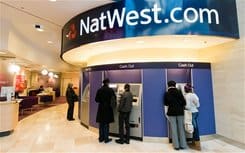NatWest Bank says it plans to reduce the number of branch managers by 361 in its quest to reduce costs. Forty-five of them will be deputy branch managers in London.
The net loss is expected to be 245 after 116 more senior positions are created. NatWest says it is also creating an additional 45 customer service posts.
NatWest is part of Royal Bank of Scotland (RBS), the state-owned bank that posted losses of £-8.243 billion ($14.02 billion) for 2013.
It expects the new positions to be filled by those whose jobs are being closed down. It cannot guarantee however, that there will not be any resulting redundancies.
There used to be five grades of branch manager at NatWest, which has reorganized them into just two grades – those in charge of large branches and those in charge of smaller units.
Earlier this year RBS closed down 48 manager jobs in Scotland.
A NatWest spokesman said all its branches will still have a manager. “This change will not affect how we serve our customers.”
Tens of thousands of jobs gone
The news follows the confirmed closure of one hundred NatWest and RBS branches during the last six months. Since the 2008 bailout by the British taxpayer, more than thirty-thousand jobs have gone across the group just in the United Kingdom.
Britain’s largest union, Unite, is urging the bank not to make any employee redundant in the latest round of job cuts.
Unite’s national officer Rob MacGregor, said:
“These latest job losses are at odds with RBS’ commitment to improve customer service and move managers closer to the customer. Crude cost cutting – and not the customer – is at the heart of the bank’s plans which will mean fewer managers, further away from the customer, with less time to improve the customer experience.”
“We need a relentless focus on the customer if public trust in the banking sector is to be renewed, not job losses to simply increase operating profits or the continued uncertainty that is plaguing loyal staff who have worked tirelessly to turn the bank around. There are major concerns around the viability of this latest restructure and the workloads for staff remaining post reorganization.”
Fear of further massive cuts
In February 2014, RBS announced that customers (including NatWest customers) would be able to make deposits and pay in cheques at any of the country’s 11,500 Post Office branches. Employees, unions and analysts fear the bank will eventually close many more branches and cut thousands more jobs.
Over the last few years, British banks have been cutting tens of thousands of jobs. Barclays, which reported a 5% decline in profits, announced that up to 19,000 jobs will go by 2016, with half the redundancies occurring in the UK. HSBC has cut 40,000 posts globally over the past three years.
Losses, job cuts but bigger bonuses
During the financial crisis, several British banks came to the taxpayer cap-in-hand asking for bailouts. There was hope that perhaps the “fat cats” in financial institutions had learned their lesson and would focus on the best interests of their employers, shareholders and customers.
Fat cats are overpaid executives. Even when their performance is poor or the company makes a loss, they still get generous bonuses.
In 2013, banking bonuses rose by 29% globally, with executives in the City of London benefitting the most.

On average, banking bonuses in London were 30% higher in 2013 compared to 2012, a significant increase given that banks have been losing money in their fixed income business. All UK banks that made losses still managed to find billions of pounds for executive bonuses.
The Royal Bank of Scotland posted a massive loss in 2013, but put aside £576 million for executive bonuses. Barclays raised bonuses for its top executives despite announcing job cuts of up to 12,000 employees to save money.
About NatWest Bank
NatWest (National Westminster Bank) is the biggest retail and commercial bank in the UK. It has been part of RBS since 2,000 and is ranked among the 10 biggest banks globally by assets.
NatWest, which today has 33,000 workers, was the result of a merger between Westminster Bank and National Provincial Bank in 1968.
It has 1,600 branches and 3,400 ATMs across the UK. NatWest has more than 850,000 small business accounts and about 7.5 million personal customers. It operates in Ireland through its Ulster Bank subsidiary.
